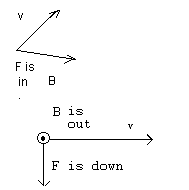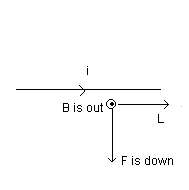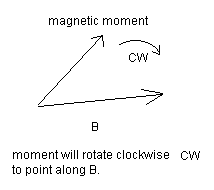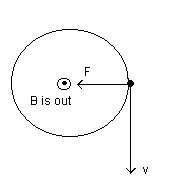| Ch.29 | 1 | 5 | 16 | 19 | 25 | 32 | 36 | 53 |
Quiz 11 |
||||||||
| Please click here to give your opinion of these hints! I am taking a survey for a future online course. It will also help improve future hints in this class. Thanks!! | ||||||||
| Chapter summary: (A) Use the right hand rule or RHR to find the direction of magnetic force vector-F on a moving charge. In the 2 examples below, assume q>0.
(B) Force on a wire: Use RHR.
|
||||||||
| 1. In each case for fig. P29.1,
analyze the direction of the force using the right-hand-rule as we did in class. For the
vector force,
|
||||||||
| 5. The magnitude of the force
is F = ma, where m is the mass of the proton and a is the
acceleration. Solve for F. Now, from the right hand rule, the magnetic field vector
is in the y-z plane. For simplicity, the problem assumes that the magnetic field vector is
perpendicular to the velocity vector, which is directed along the positive z-axis. Thus,
|
||||||||
| 16. Study fig. P29.16. The
force of gravity points down. Thus the magnetic force points up. The magnetic field vector
points in. Use the formula,
Clearly, the current i is in the plane of the paper and is perpendicular to the vector magnetic field, which, again, points into the paper (in). The vector length points in the same direction as the current i. Thus,
Use the right hand rule for the cross product:
to determine whether the current (which, again, is in the same direction as the vector length) points to the left or to the right. |
||||||||
| 19. Let the
x-direction be along the wire in the direction of the current, the z direction be upward,
and the y direction be rightward in fig. P29.19. Thus, if I represents the current,
Now, from Ch. 7, the work done by the magnetic force equals the change in kinetic
energy. And the kinetic energy has two components, transnational and rotational.
Review Ch. 11.
Here, I represents the moment of inertia and v = the linear speed
of the center of mass. Go to Ch. 10 and look up the moment of inertia of a solid
cylinder of mass m and radius R. Also, the magnitude of the force is: |
||||||||
| 25. Use the definition for the
torque vector on a loop in a magnetic field: This is the cross product between the magnetic moment vector and the B-vector. Study fig. 29.14. Wrap your right fingers around the loop in the direction of the current, and your thumb will point perpendicular to the plane of the loop. In the case of fig P29.25, your thumb will point at an angle of 60 degrees with the B-vector. Thus, the magnitude of the torque is:
Here,
|
||||||||
| 32. Please read sec. 29.4. You
also will need to review the Ch. 25 quiz on the relationship between the change in kinetic
energy and the potential: Solve for the speed. Also, [Note that from lecture in discussion section, a negative particle will travel in the opposite direction (i.e. clockwise) of the positive particle (traveling counterclockwise in fig. 29.17). These opposite directions form the basis of the technology of high energy physics accelerators, in which oppositely charged particles under the influence of a magnetic field travel oppositely in a circle, and undergo a "head-on" collision. The reaction by-products are studied to investigate the fundamental forces of nature and the origins of the universe! For more information, click here, take a look at the page, and then explore this very interesting site .] Solve the above equation for r. |
||||||||
| 36. (a): Thus, qrB = mv (Eqn. 1) Note that here q is the magnitude of the electron charge. Review sec. 11.3, ex 11.6, page 314 (Vol 1 of 4th Edition) for the definition of the magnitude of the angular momentum: L = mvr (Eqn. 2). Substitute Eqn. 1 into Eqn. 2 to eliminate v. Finally, solve for r in terms of L, q, and B. (b) Use Eqn. 2 above to solve for v. |
||||||||
| 53. Please study fig.
29.23 for a picture of a charged particle entering a region of a uniform magnetic field.
The particle enters with a velocity perpendicular to the boundary, and moves along a half
circle of radius r until it reemerges from the region with a velocity pointed in
the opposite direction. Thus, the maximum depth of penetration is the radius r. (a):
Solve for t (Hint: What is the angle for a half-circle ?) Solve for the speed using Eqn. 1 in part (a). Then substitute into Eqn. 2 to get the kinetic energy. |
||||||||




